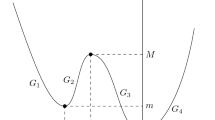Abstract
The one-dimensional case of the homogeneous Hamilton–Jacobi and Bernoulli equations St \({\raise0.7ex\hbox{$1$} \!\mathord{\left/ {\vphantom {1 2}}\right.\kern-\nulldelimiterspace}\!\lower0.7ex\hbox{$2$}}\)S 2x =0, where S(x, t) is Hamilton's principal function of a free particle and also Bernoulli's momentum potential of a perfect liquid, is considered. Non-elementary solutions are looked for in terms of odd power series in t with x-dependent coefficients and even power series in x with t-dependent coefficients. In both cases, and depending upon initial conditions, unexpected regularities are observed in the terms of these expansions and this suggests that S(x, t) should be written as a product of the elementary solution x2/(2t) and a function f=f(φ) where φ=φ(x, |t|) owing to the symmetry property which is that S(x, −t)=−S(x, t). Requiring that this Ansatz satisfies the said equation and choosing the simplest realization of φ(x, |t|)=φ0 |t/t0|κ (x/x 0)λ≥0 with κ, λ∈ ℝ results in a soluble ordinary differential equation, of first order in u=ln φ and quadratic in f. This ODE has two fixed points: f=1, obviously, and f=0, a new fixed point which is often called “trivial.” The phase plane (fu, f) consists of a family of parabolas, all of which pass through the two fixed points. Explicit solutions of the general case are given close to these fixed points. A one-parameter family of solution is found to emerge from the “trivial” fixed point with non-trivial initial values S(x, 0). Detailed analyses of these findings will be reported elsewhere, bearing in mind that Bernoulli's equation has to be supplemented by the continuity equation satisfied by the density of the liquid.
Similar content being viewed by others
REFERENCES
Ph. Choquard, “Traitement semi-classique des forces générales dans la représentation de Feynman,” Helv. Phys. Acta 28, 89–157 (1955).
Wolfgang Pauli, “Sources in the History of Mathematics and Physical Sciences 15,” in Scientific Correspondence, Vol. IV. Part II, 1953-1954, Karl von Meyenn, ed. (Springer, Berlin, 1999), pp. 84–89 and 105.
Ph. Choquard, “Toward a canonical Hamiltonian and microscopic field theory of classical liquids,” Physica A 279, 45–59 (2000).
Ph. Choquard and R. Rentsch, “H-stability and `weak' collapse,” Physica A 138, 125–136 (1986).
Ph. Choquard and F. Steiner, “The story of Van Vleck's and Morette-Van Hove's determinants,” Helv. Phys. Acta 69, 636–654 (1996).
W. A. Wojczyński, Burgers-KPZ Turbulence (Lecture Notes in Mathematics, Vol. 1700) (Springer, Berlin, 1998).
L. C. Evans, Partial Differential Equations (Graduate Studies in Mathematics, Vol. 19) (American Mathematical Society, Providence, Rhode Island, 1999), Sec. 3.3 and Chap. 10. 640 Choquard
Author information
Authors and Affiliations
Rights and permissions
About this article
Cite this article
Choquard, P. The Homogeneous Hamilton–Jacobi and Bernoulli Equations Revisited. Foundations of Physics 31, 623–640 (2001). https://doi.org/10.1023/A:1017517026015
Issue Date:
DOI: https://doi.org/10.1023/A:1017517026015



